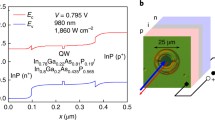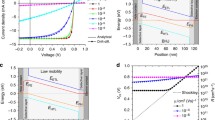Abstract
After the contribution of hot carriers to the current in solar cells has been considered, a physical and analytical model of open-circuit voltage is proposed. A variety of experiments on the temperature-dependent open-circuit voltage in solar cells that is one critical factor to determine their overall efficiency are successfully modeled based on the consideration of hot carriers. While previous modeling studies focused on numerical techniques, a physical and analytical model of the open-circuit voltage has been developed. Such a study is an important step toward a quantitative model of solar cells, leading to a deeper understanding of the physical effects in these materials. The analysis of the open-circuit voltage reveals how it depends on temperature, the acceptor density, the light-generated current density, the donor density, the bandgap, the effective mass, and the dielectric constant. A material parameter variation is performed to understand its effects on the open-circuit voltage. It will benefit to optimize the device performance by tuning material parameters through the simplicity and analytic nature of the proposed model. It is also helpful to characterize the material properties using the open-circuit voltage.








Similar content being viewed by others
References
C.J. Brabec, A. Cravino, D. Meissner, N.S. Sariciftci, T. Fromherz, M.T. Rispens, L. Sanchez, J.C. Hummelen, Adv. Funct. Mater. 11, 374 (2001)
M. Kauk, M. Altosaar, J. Raudoja, A. Jagomägi, M. Danilson, T. Varema, Thin Solid Films 515, 5880 (2007)
X. Fang, S. Ren, C. Li, C. Li, G. Chen, H. Lai, J. Zhang, L. Wu, Sol. Energ. Mat. Sol. C. 188, 93 (2018)
Z. Jin, A. Wang, Q. Zhou, Y. Wang, J. Wang, Sci. Rep. 6, 37106 (2016)
F. Gao, W. Tress, J. Wang, O. Inganäs, Phys. Rev. Lett. 114, 128701 (2015)
A.K. Thakur, G. Wantz, G. Garcia-Belmonte, J. Bisquert, L. Hirsch, Sol. Energ. Mat. Sol. C. 95, 2131 (2011)
D. Rauh, A. Wagenpfahl, C. Deibel, V. Dyakonov, Appl. Phys. Lett. 98, 69 (2011)
A. Castro-Carranza, J.C. Nolasco, N. Reininghaus, S. Geißendorfer, M. Vehse, J. Parisi, J. Gutowski, T. Voss, Appl. Phys. Lett. 109, 043503 (2016)
S.R. Raga, E.M. Barea, F. Fabregat-Santiago, J. Phys. Chem. Lett. 3, 1629 (2012)
C.M. Ramsdale, J.A. Barker, A.C. Arias, J.D. MacKenzie, R.H. Friend, N.C. Greenham, J. Appl. Phys. 92, 4266 (2002)
N. Tessler, J. Appl. Phys. 118, 215501 (2015)
F. Babbe, L. Choubrac, S. Siebentritt, Solar RRL 2, 1800248 (2018)
V.D. Mihailetchi, P.W.M. Blom, J.C. Hummelen, M.T. Rispens, J. Appl. Phys. 94, 6849 (2003)
K. Vandewal, K. Tvingstedt, A. Gadisa, O. Inganäs, J.V. Manca, Nat. Mater. 8, 904 (2009)
B.P. Rand, D.P. Burk, S.R. Forrest, Phys. Rev. B 75, 115327 (2007)
C.J. Brabec, A. Cravino, D. Meissner, N.S. Sariciftci, M.T. Rispens, L. Sanchez, J.C. Hummelen, T. Fromherz, Thin Solid Films 403, 368 (2002)
W.J. Potscavage Jr., S. Yoo, B. Kippelen, Appl. Phys. Lett. 93, 413 (2008)
D.C. Olson, S.E. Shaheen, M.S. White, W.J. Mitchell, M.F. van Hest, T.R. Collins, D. S. Ginley. Adv. Funct. Mater. 17, 264 (2007)
R.A. Street, D. Davies, P.P. Khlyabich, B. Burkhart, B.C. Thompson, J. Am. Chem. Soc. 135, 986 (2013)
M. Shaban, M.A.G. El-Sayed, Appl. Surf. Sci. 254, 7901 (2008)
M. Mikolášek, J. Racko, L. Harmatha, Appl. Surf. Sci. 395, 166 (2017)
M.T. Neukom, A. Schiller, S. Züfle, E. Knapp, J. Ávila, D. Pérez-del-Rey, C. Dreessen, K.P.S. Zanoni, M. Sessolo, H.J. Bolink, B. Ruhstaller, A.C.S. Appl, Mater. Interfaces 11, 23320 (2019)
F. Wu, C. Chen, Y. Zhao, H. Zhang, X. Li, W. Lu, T. Zhang, J. Electrochem. Soc. 161, H593 (2014)
B. Kitchen, O. Awartani, R.J. Kline, T. McAfee, H. Ade, B.T. O’Connor, A.C.S. Appl, Mater. Interfaces 7, 13208 (2015)
P.P. Khlyabich, A.E. Rudenko, R.A. Street, B.C. Thompson, A.C.S. Appl, Mater. Interfaces 6, 9913 (2014)
F. Wu, Q. Cui, Z. Qiu, C. Liu, H. Zhang, W. Shen, M. Wang, A.C.S. Appl, Mater. Interfaces 5, 3246 (2013)
S.L. Chang, K.E. Hung, F.Y. Cao, K.H. Huang, C.S. Hsu, C.Y. Liao, C.H. Lee, Y.J. Cheng, A.C.S. Appl, Mater. Interfaces 11, 33179 (2019)
N. Felekidis, A. Melianas, M. Kemerink, A.C.S. Appl, Mater. Interfaces 9, 37070 (2017)
D.K. De, O.C. Olawole, Proc. SPIE 9927, 99270E (2016)
L.F. Mao, H. Ning, J.Y. Wang, PLoS ONE 10, e0128438 (2015)
L.F. Mao, H. Ning, Z.L. Huo, J.Y. Wang, Sci. Rep. 5, 18307 (2015)
L.F. Mao, H. Ning, Z. Lu, G. Wang, Sci. Rep. 6, 24777 (2016)
L.F. Mao, ETRI J. 39, 284 (2017)
L.F. Mao, J. Wang, L. Li, H. Ning, C. Hu, Carbon 119, 446 (2017)
L.F. Mao, Appl. Phys. A 125, 325 (2019)
L.F. Mao, Appl. Phys. Lett. 90, 183511 (2007)
L.F. Mao, Appl. Phys. Lett. 91, 123519 (2007)
L.F. Mao, I.E.E.E. Electron, Dev. Lett. 28, 161 (2007)
L.F. Mao, I.E.E.E. Trans, Electron. Dev. 55, 782 (2008)
L.F. Mao, Solid State Electron. 52, 186 (2008)
L.F. Mao, ETRI J. 32, 68 (2010)
L.F. Mao, Pramana. J. Phys. 72, 407 (2009)
L.F. Mao, Pramana. J. Phys. 93, 11 (2019)
S.M. Sze, K.K. Ng, Physics of Semiconductor Devices (Wliey, New York, 2007)
V.K. Khanna, Extreme-Temperature and Harsh-Environment Electronics (IOP Publishing Limited, Bristol, 2017)
D. Cheyns, J. Poortmans, P. Heremans, C. Deibel, S. Verlaak, B.P. Rand, J. Genoe, Phys. Rev. B 77, 165332 (2008)
L.F. Mao, Silicon (2019). https://doi.org/10.1007/s12633-019-00249-8
J. Lutz, H. Schlangenotto, U. Scheuermann, R. De Doncker, Semiconductor Power Devices (Springer, Berlin, 2011)
Acknowledgements
The author acknowledges financial support from the National Natural Science Foundation of China under Grant No. 61774014.
Author information
Authors and Affiliations
Corresponding author
Additional information
Publisher's Note
Springer Nature remains neutral with regard to jurisdictional claims in published maps and institutional affiliations.
Rights and permissions
About this article
Cite this article
Mao, LF. Physical origin of the temperature-dependent open-circuit voltage in solar cells. Appl. Phys. A 126, 42 (2020). https://doi.org/10.1007/s00339-019-3224-2
Received:
Accepted:
Published:
DOI: https://doi.org/10.1007/s00339-019-3224-2




